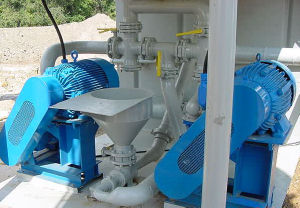Oil and Gas Well Drilling and Servicing eTool
Drilling Ahead » Drilling Fluid
Topics on this page include:

Drilling fluid is an important component in the drilling process. A fluid is required in the wellbore to:
- Cool and lubricate the drill bit,
- Remove the rock fragments, or drill cuttings, from the drilling area and transport them to the surface,
- Counterbalance formation pressure to prevent formation fluids (such as oil, gas, and water) from entering the well prematurely (which can lead to a blowout), and
- Prevent the open (uncased) wellbore from caving in.
There are several types of drilling fluids used depending on the drilling conditions encountered:
- Water-based muds are used most frequently. The base may be either:
- fresh water, or
- salt water.
- Oil-based muds
- Synthetic materials. The oil and gas extraction industry has developed many new oleaginous (oil-like) base materials from which to formulate high-performance drilling fluids. A general class of these fluids is called synthetic materials, such as
- The vegetable esters,
- Poly alpha olefins,
- Internal olefins,
- Linear alpha olefins,
- Synthetic paraffins,
- Ethers, and
- Linear alkylbenzenes, among others.
- Air and foam fluids may be used in drilling wells.
- These fluids are less dense than drilling muds.

Drilling muds typically have several additives. (Air and foam fluids typically do not contain many additives because the additives are either liquid or solid, and will not mix with air and foam drilling fluids.) The following is a list of the more significant additives:
- Weighting materials, primarily barite (barium sulfate), may be used to increase the density of the mud in order to equilibrate the pressure between the wellbore and formation when drilling through particularly pressurized zones. Hematite (Fe2O3 ) sometimes is used as a weighting agent in oil-based muds (Souders, 1998).
- Corrosion inhibitors such as iron oxide, aluminum bisulfate, zinc carbonate, and zinc chromate protect pipes and other metallic components from acidic compounds encountered in the formation.
- Dispersants, including iron lignosulfonates, break up solid clusters into small particles so they can be carried by the fluid.
- Flocculants, primarily acrylic polymers, cause suspended particles to group together so they can be removed from the fluid at the surface.
- Surfactants, like fatty acids and soaps, defoam and emulsify the mud.
- Biocides, typically organic amines, chlorophenols, or formaldehydes, kill bacteria and help reduce the souring of drilling mud.
- Fluid loss reducers include starch and organic polymers and limit the loss of drilling mud to under-pressurized or high-permeability formations.

